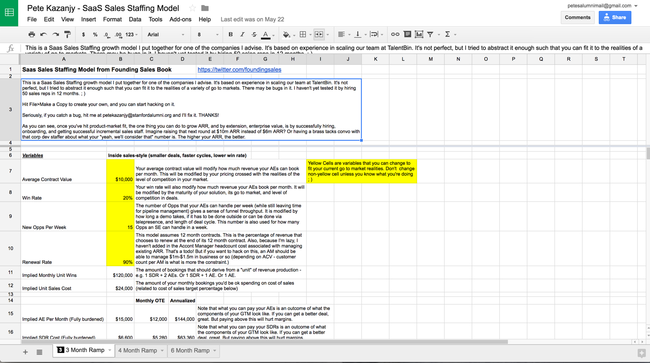Staffing and scaling a SaaS sales org? I’ve got a model for YOU.
 Did anyone need a model?
Did anyone need a model?
About a year ago a founder of one of the companies I invested in and advise was asking me some questions over email about scaling a SaaS sales org.
Specifically she was thinking through the costs, timelines, and outputs of hiring sales staff, whether SDRs or AEs, and how that eventually turned into a growing business. Rather than just email back and forth on the specifics of her organization, I decided it would be best to create an abstracted, basic Google Spreadsheet model that could be used to see the interlocking parts of how that might work for a given organization, based on certain inputs (like their Average Selling Price, win rate, and more.) And that way other organizations might be able to use it.
You can find that model here:

But then I started tweaking it some. I started out with just one tab, and one AE ramp time (3 months), but then forked the tabs to have three different ramp times, for slower deal cycle organizations. Then I added in a concept of renewal rate, to help demonstrate revenue retention after the initial contract term was over.
Eventually it got pretty robust, so much so that I like to share with with folks who are asking good ways to think about scaling their sales org, and don’t want to start at zero. It’s been used by a few dozen sales orgs to inform their growth thinking, and I’m going to be including it in Founding Sales
The model is definitely missing things, and I try to call it out in comments in the various cells, and such. There’s no concept of “Sales Engineering”, which might be problematic for organizations that need to staff SEs for a technical sale. There’s no concept of Customer Success and Support staffing and their associated costs, even though this is important, and will impact the scaling of your org. And there definitely aren’t things like marketing costs, real estate, or engineering staff! So feel free to fork the Google sheet, and get your hands dirty extending the model.
While this isn’t a full operating model, it can be helpful for founders and sales leaders alike for thinking about the impacts to their business, both the negative, short term costs associated with paying a sales rep while they are not yet producing revenue, and the positive, as productive reps later add recurring revenue to your organization.
If you like this, follow @foundingsales. It’s got the good stuff.